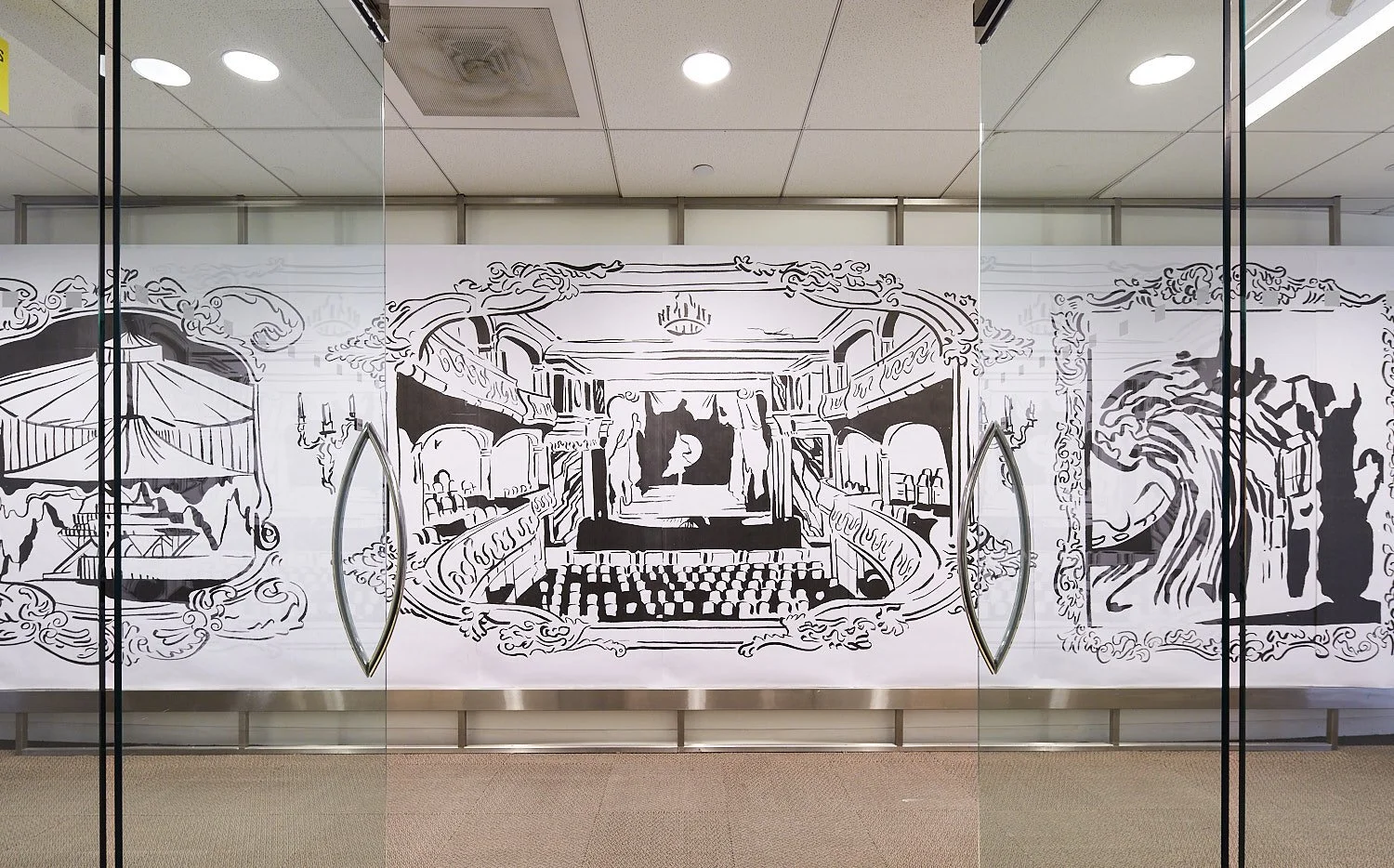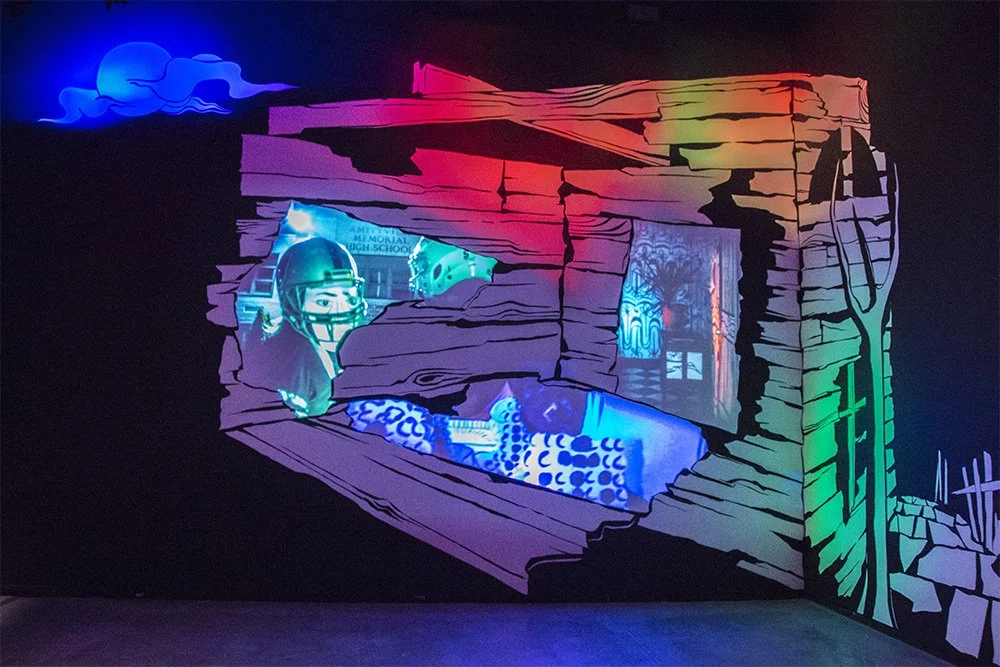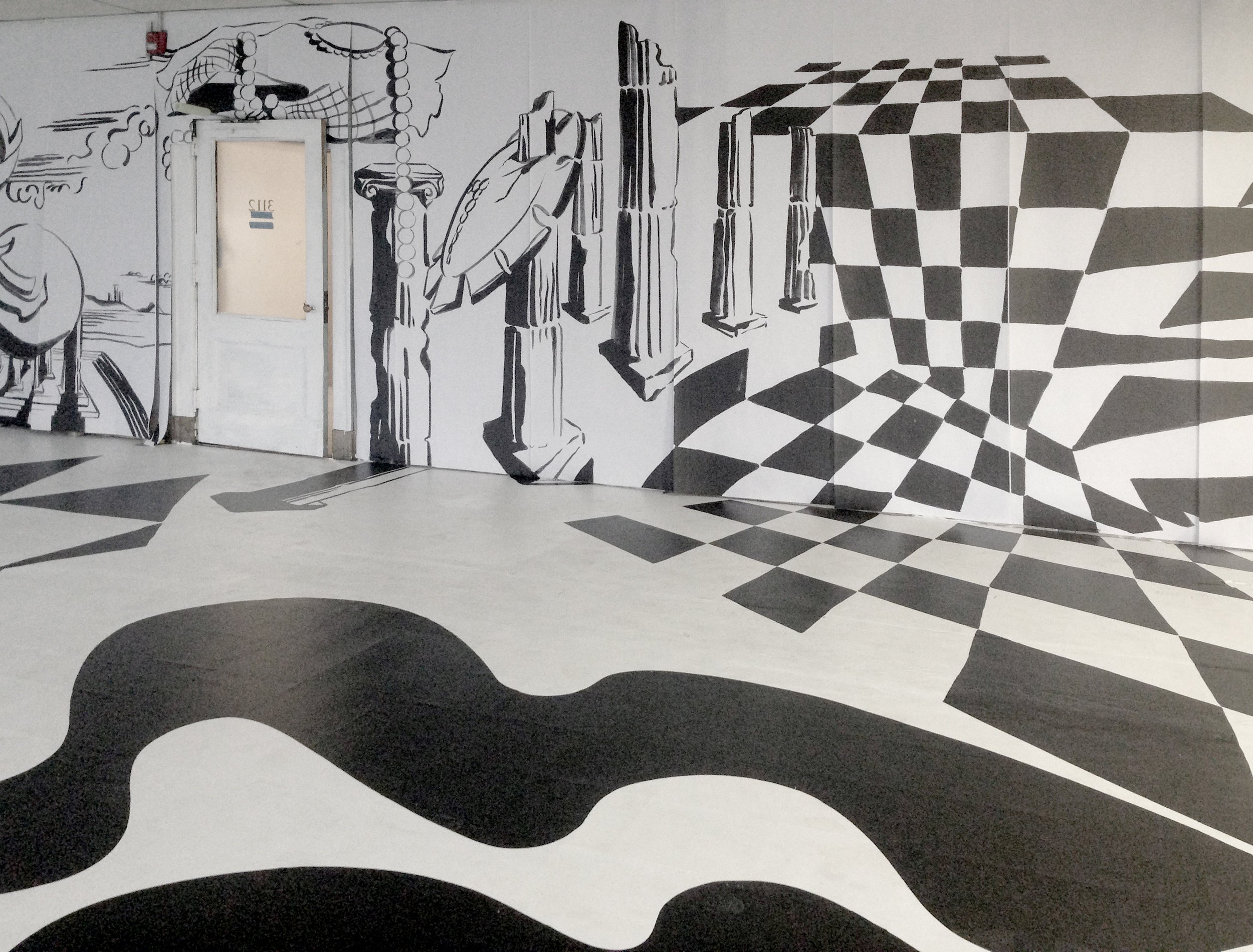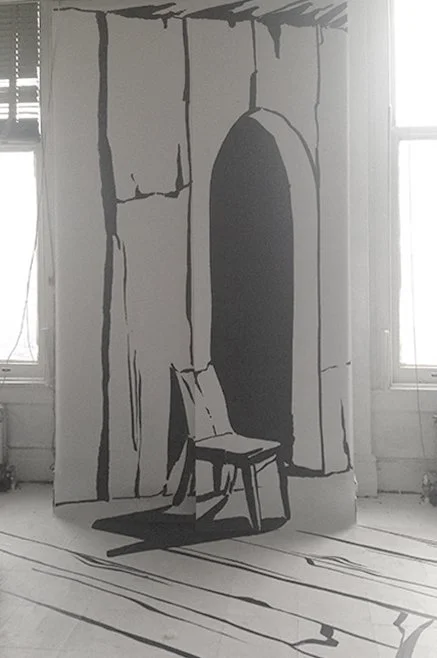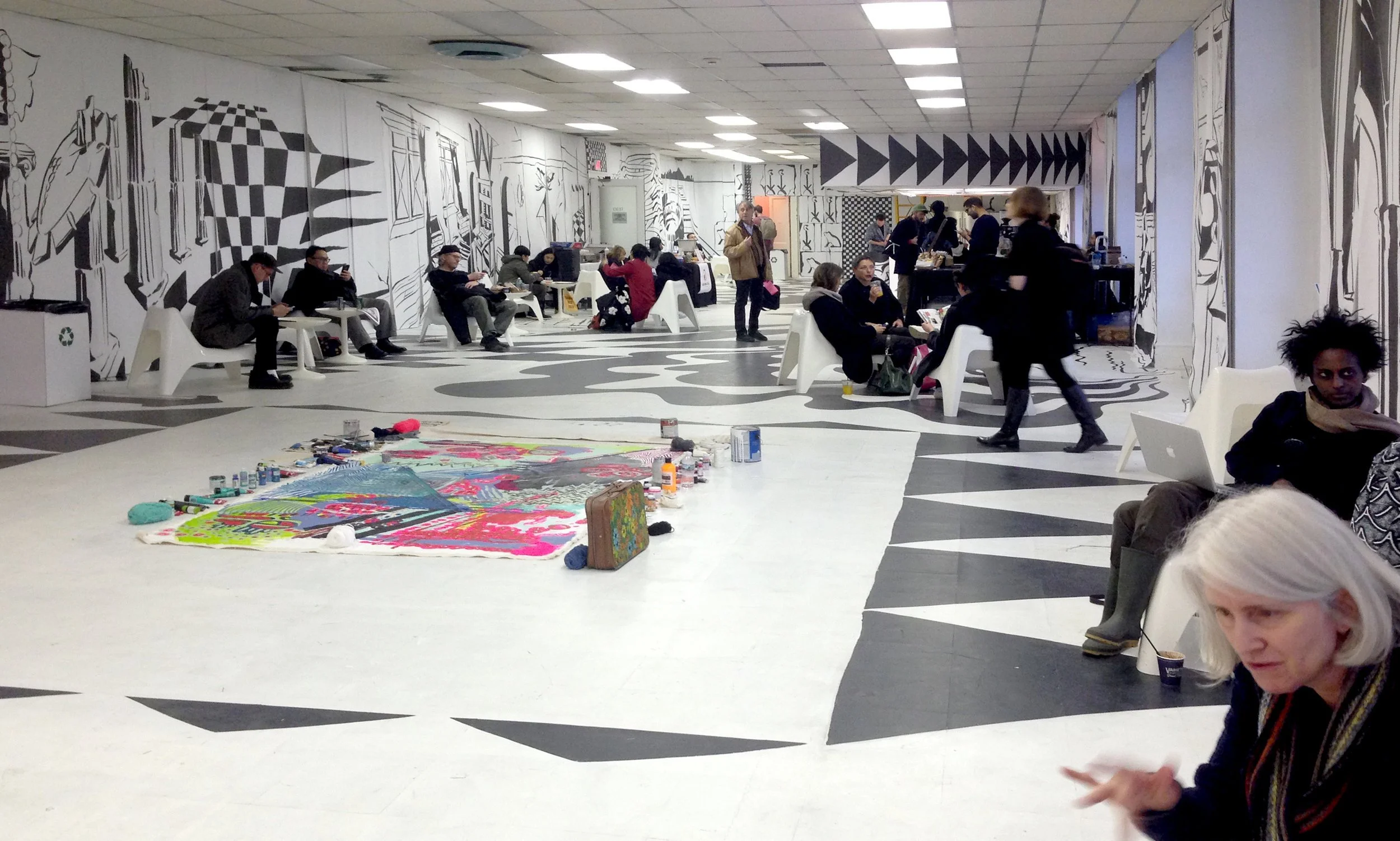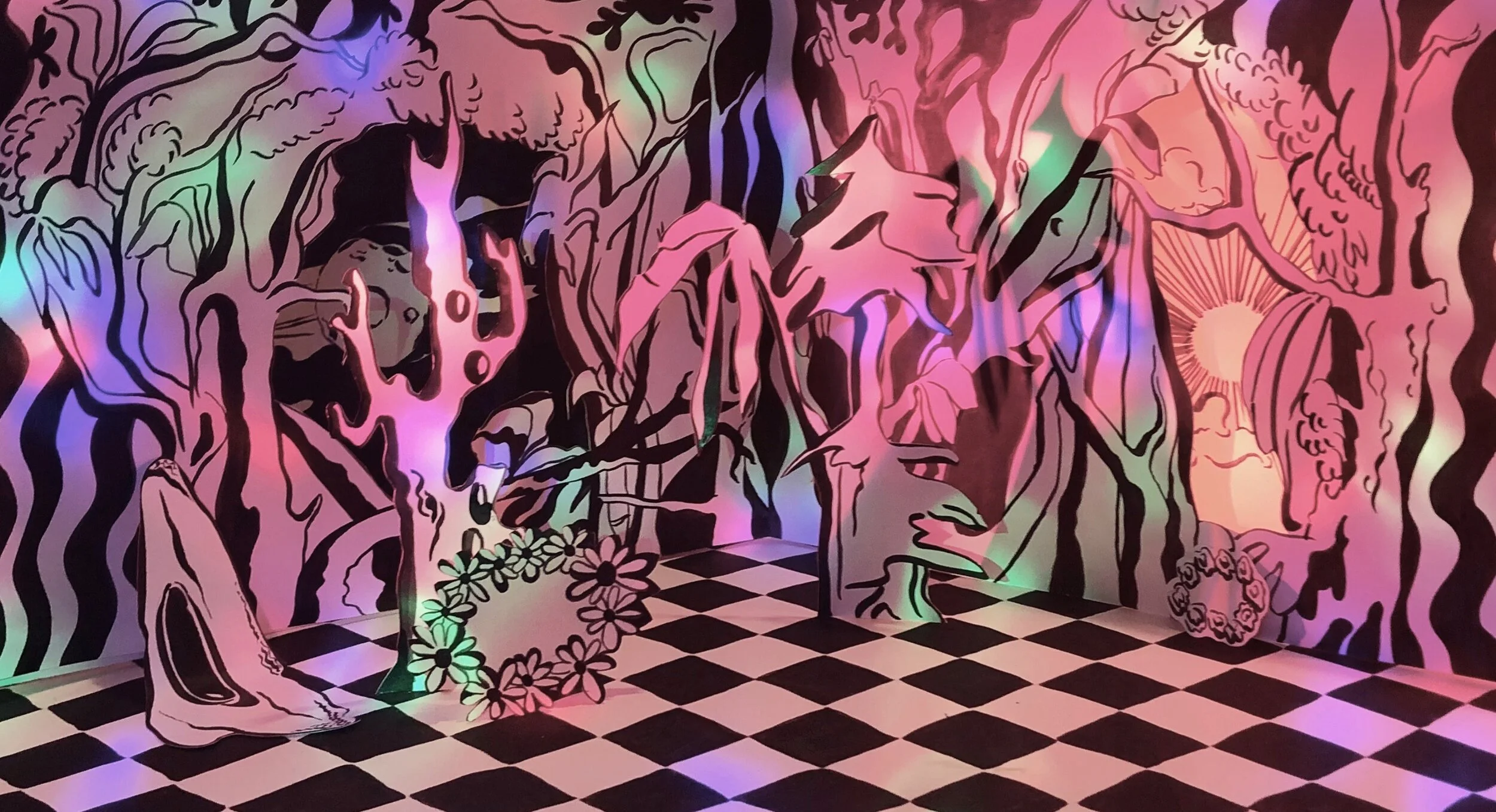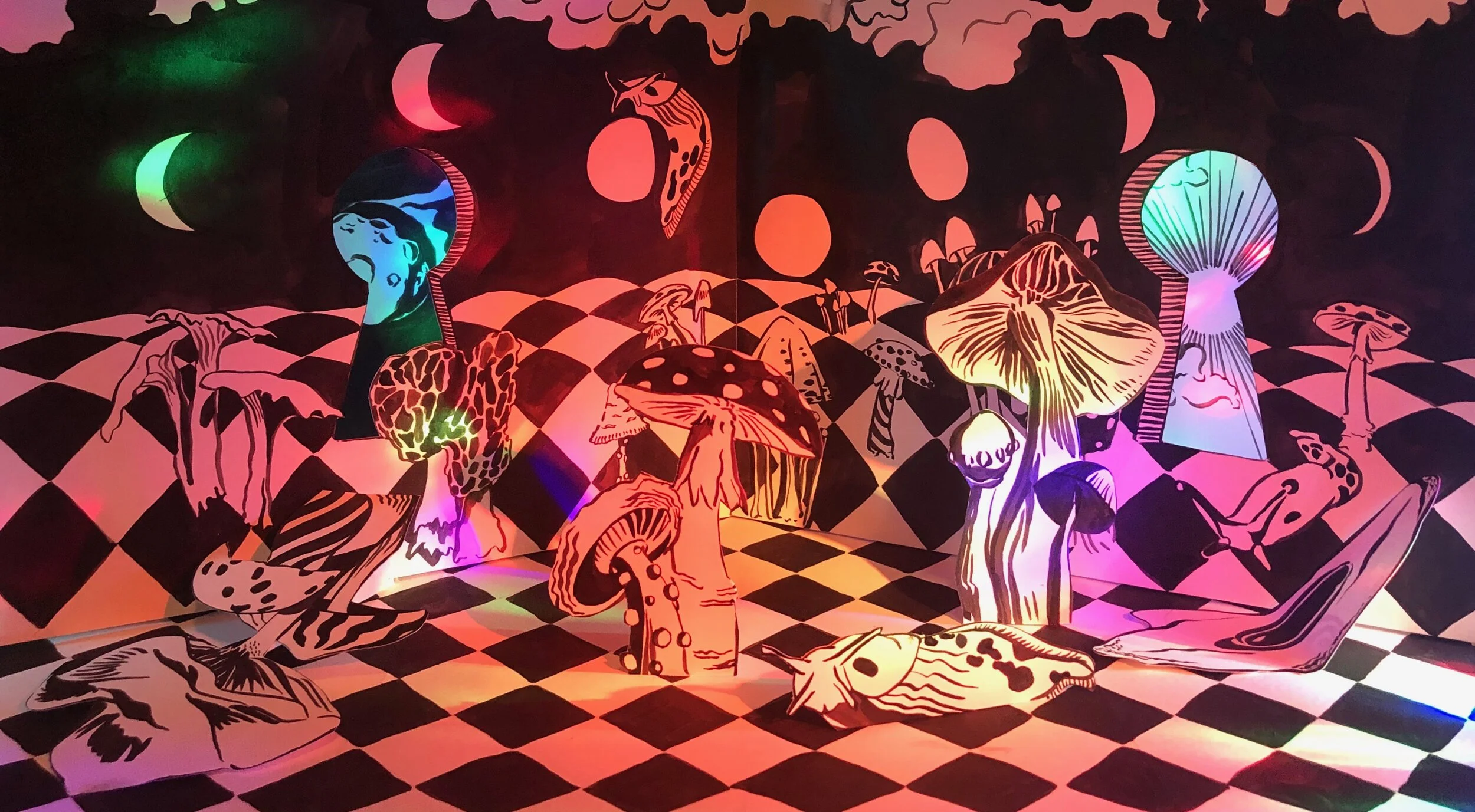Research Statement & Portfolio
Jessica Mensch
Research Statement
My work straddles multiple media and draws from contemporary painting practices, feminist theory, and media studies. Operating at the intersection of painting and theatrical set design, broadly my work investigates thresholds of medium specificity, perception and knowledge, and those liminal spaces where these frameworks both inform and confuse one another.
My installation works use traditional illusionistic devices such as theatrical scrims, mirrors, and painted scenic backdrops and theatrical flats, which I combine with video projection, projection mapping, live-feed video, LED lighting, and other contemporary tools. The material elements of my installations often function as performing subjects, each of which presents a different vantage point and part of the story I am telling. This approach to painting allows me to rethink and reimagine my subjects in new ways.
My most recent work, The Grotto (2024), was funded by the Canada Council for the Arts. The work consists of a painted backdrop measuring 14’ wide by 8’ high, video (live-feed and prerecorded) projected on the backdrop, a small electronic water wheel, and sound.
This installation contemplates the grotto, specifically the artificial garden grotto - most popular in Europe between the 16th and 18th centuries. These grottoes resemble caves, with the addition of fountains, sculptures of nymphs and Greek and Roman gods, automata such as mechanical singing birds, and are often encrusted with seashells and corals from Western Africa and the West Indies.
The statuary from ancient Rome and Greece (or reproductions thereof), symbolized an intellectual and cultural throughline from classical antiquity to Renaissance Europe. The inclusion of shells and corals, etc., from Europe’s new colonial outposts supported the perception that Europe’s colonial efforts were part of this cultural bedrock of Western European civilization.
The Grotto touches upon the garden grotto’s place in colonial history through parody and repetition. It is part painting and part projection - a fiction. Classical nymphs (played by me) lounge disinterestedly on their smartphones. A crude mechanical bird keeps time like a cuckoo clock until it unceremoniously drops dead, only to reappear seconds later. A painting of a bust of a Classical goddess flips up and down in time with the strum of a harp. A marionette with billowing green hair intermittently plays the conch trumpet, summoning the image of a spinning shell from the center cavity. In front of this video installation, a small mechanical water wheel pushes shells and paper boats in circles. This water sculpture is filmed with a webcam. The live-feed video is projected onto the bottom half of the video installation. Sounds of bells, water, birds, harps and conch horns fill the air. The colour palette of The Grotto slowly shifts, cycling through both dark and light palettes. Pulling from my experience as a painter, I used colour theory to optically mix the colours in my painting with those of my mapped video projection. Here, the bright reds in my painting read as deep purplish greys when overlaid with the turquoise light of my projection, and so on.
Another work of mine, Hecate’s Palladio (2019), considers the role that women perform in Freud’s theory of “the uncanny.” Researching 19th and 20th century figurations of the uncanny, I discovered that performances in magic shows of the time commonly included the disappearance, reappearance, beheading and bisection of women. It was impossible not to see, within these performances, a correlation with the witch trials of 16th- and 17th-century England, where women accused of witchcraft were punished in ways resembling the theatrical violence performed on women during these magic shows. Responding to this connection, I created the four works of my installation: “Astronomical Loop,” “Hecate’s Palladio,” “A Door,” and “She.” These works were bound together by the character Hecate, a purveyor, in Roman mythology, of both sorcery and magic, who exists on a plane between life and death.
My creative practice has always been nourished by collaborative work. Most recently I worked with artists Michelle Sylliboy (Mi’kmaq/L’nu), Leigh Gillam (settler), and Antoinette Karuna (settler) to interpret the Treaty Relationship as a liminal space of creation. Using the L’nuk komqwejwi’kasikl language, we created a hieroglyphic poem, which we then animated into a short video titled Exploring the Treaty Relationship. This work, commissioned by Nocturne, was screened at the Art Gallery of Nova Scotia.
While this project marks my most recent collaboration, I am a member of two long-standing collaborative projects. The first, “Inflatable Deities,” was established in 2011. It is a collaborative duo working across the areas of video, installation, performance, and music. The second, “The Powers,” founded in 2014, is at once a band, an artistic collaboration, and a research group committed to weaving alternate realities through video, music, storytelling, dance, and ritualistic performance. Our most recent creation is Sistership TV, a 4-episode web series that draws from our collective research on ecology, media studies, materialist theory, and feminist theory. Structured as a series of short sketches, it was supported by SSHRC grant and co-produced by 17 international and Canadian artists and collaborators.
I am currently continuing my research on the grotto and the prominent position held by classical mythology and architecture in contemporary Western culture.
1. The Grotto (2024)
14' x 8', acrylic on muslin, video, webcam, electric water wheel
The Grotto is a video installation. It consists of a painted backdrop measuring 14’ wide by 8’ high, video (live-feed and prerecorded) projected on the backdrop, a small electronic water wheel, and sound.
video documentation: The Grotto, 2024
2 - 5. Hecate’s Palladio installation (2019)
The four following works, Hecate’s Palladio (2019), Astronomical Loop (2018), She (2019), and A Door(2019), are bound together by the character Hecate, a purveyor, in Roman mythology, of both sorcery and magic who exists on a plane between life and death. As a figure who occupies both symbolic and real thresholds, I situated Hecate within the symbolic architecture of a theatrical set. In this way, viewers could experience the uncanny through the lens of a unifying female character whose perspective enables a feminist reckoning.
2. Hecate’s Palladio (2019)
15' x 10', jacquard dye on muslin, video
Hecate's Palladio consists of a painted theatrical drop depicting an ancient Roman architectural facade that typically framed an amphitheater stage. Two images of Hecate are projected onto the drop, both lighting it and adding a layer of illusion to my painted facade. In the course of a three- minute loop, both Hecate’s leave theirbodies to explore the facade, climbing and moving along its surface.
video documentation: Hecate’s Palladio, 2019
3. She (2019)
3’wide x 4’high x 3’long, pepper’s ghost hologram (video, monitor, plexiglass), mirror, table, masks, fake candles
She conjures up for the viewer the illusion of a 19th-century magic trick where the female assistant is burnt alive while sitting atop a small table. In my version, Hecate’s head stands in for the magician’s assistant. Through her eye openings viewers could watch the moving image of a Cockatoo on a staircase—an illusion created using a mid-nineteenth century technique called “Pepper's Ghost”—indicating that Hecate is no longer the passive assistant but has become the necromancer herself. With a head no longer attached to a body, the presence of Hecate points to different kinds of embodiment and seeing, viewpoints whosepurchase draws the viewer in even as it unbalances them.
video documentation: She, 2019
4. Astronomical Loop (2018)
8’ x 8’, acrylic on canvas, video projection, humidifier, LED
Astronomical Loop consists of an 8' x 8' painting of a spherical celestial body. A soft turquoise light illuminates this. As time passes the viewer will see that the light, rather than stagnant, slowly crosses the surface, mimicking the phases of our moon. Here, the figure of Hecate is evoked, for she has long been associated with the moon. The phasing my celestial body is in fact a video projection that repeats every ten minutes. A small body of water in the lower left corner of the planet also follows the logic of this phasing,oscillating from being fully lit to disappearing beneath shadow. One element that maintains its continuity throughout this loop is a volcanic orifice that spews vapor and fire. On closer inspection, this too is an illusion, created by placing a humidifier and red LED behind a hole cut in the canvas.
video documentation: Astronomical Loop, 2018
5. A Door (2019)
4’x8’ painting in acrylic on canvas, video projection, 2 webcams
A Door consists of a video feedback loop using two webcams and a projector. The combined live- feed is projected on a 4' x 8' painting of a door rendered in black acrylic on canvas. The feedback loop created bythe webcams and a projector pointed at the canvas illuminate the work with an icy blue glow, punctuated by afterimages of the painting and its viewer. This work, in the context of the others, recalls the threshold between life and death occupied by Hecate, as well as the liminal space of hallucinatory visual 'trails' and early artistic experiments in video.
video documentation: A Door, 2019
6. Staged Vision (2017)
Drawing installation that consisted of 2 panels, each 20’ x 8’
This work was installed at Spring/Break Art Show 2017, Black Mirror, in New York, NY.
This work is based on my research of various theatrical spaces, particularly those that incorporated illusionistic devices such as distorted mirrors.
7. I Babysat for Those Fools (2016)
25’ x 20’, latex, video projection, LEDs
I Babysat for Those Fools is an installation by Inflatable Deities - a collaboration with Emily Pelstring. Thiswork consists of a mural interlaced with a series of videos. The videos are dramatic reenactments based on the anecdotal accounts by Amityville residents during the 1970s, when a horrific murder shook the town and subsequently fueled the Amityville Horror fiction franchise.
Curated by Darryn Doull for the exhibition, In the Shadow of the Millennium, at the Judith and Norman Alix Art Gallery in Sarnia, Ontario, 2016.
8. Gutenberg’s Galaxy (2016)
Drawing installation for the lounge and performance area of Spring/Break Art Show 2016, COPYPASTE, in New York, NY. The installation was 60’L x 20’W x 8’
This large-scale drawing installation took inspiration from Marshal McLuhan’s text, The Gutenberg Galaxy: The Making of Typographic Man (1967).
9. Chromatrope (2015)
14’ diameter, 10 oil on canvas paintings, wood, LEDS, sandbags
Chromatrope explores the resonance between two experiences of painting: painting as a contained object through which one understands a world, and painting as a theatrical medium with implications beyond itself. This work was installed at the Confederation Centre for the Arts in Charlottetown, PEI. Curated by Pan Wendt.
10. Dioramas (series of 4, 2020)
2.5’ x 2.5’ x 1’, ink on paper, LED lighting, 2020
These miniature hand drawn installations function as performing subjects, each of which presents a different vantage point or part of a story. This series includes 6 dioramas, employed as stages for examining narratives around colonialist expansion and exploration.
I used several of them in my livestream video work commissioned for Field Trips: Art Across Canada.This was work was curated by Pan Wendt at the Confederation Centre Art Gallery in Charlottetown, PEI.
11. Hecate’s Palladio (2020)
Livestream video work commissioned for the Ann Arbor Film Festival, and Field Trip: Art Across Canada
Hecate’s Palladio 12:49 mins (please watch ast 4 minutes)
12.-13. The Fuzz (series of 7 paintings, 2012)
Oil on canvas, various dimensions
This series is a portrait of world where ideas are projected into space from bodiless minds. The paintings in this series are the collective hallucination or the synthesized projections of four bodiless minds as they journey through a black and white paper forest, converging at various times, teasing out a narrative.
The Catch, 54” x 34”, oil on canvas
Santa Banshee, 48” x 36”, oil on canvas
14.-15. The Pleasure Principle (series of 3, 2009)
Oil on canvas, various dimensions
I'm showing this to share that my skill set as an artist includes different kinds of painting. Although I now seldom do figurative work in this vein, the skill and discipline involved in making these paintings taught me about oil painting and how to carve out a creative practice.
Nick and Stef, 60” x 40”, oil on canvas, 2009
Greg Under the Rainbow, 50” x 38”, oil on canvas, 2009
Esten, 54” x 34”, oil on canvas, 2009
16.-17. The Wrong Feeling (series of 7, 2007-2009)
Oil on canvas, 4’ x 4’
This series consists of seven figurative paintings of friends. Again, I'm showing this work to share that my skill set as an artist includes different kinds of painting.
Shane, 48” x 48”, oil on canvas, 2008
Susana, 48” x 48”, oil on canvas, 2009
Esten, 48” x 48”, oil on canvas
Duncan, 48” x 48”, oil on canvas
Video Collaborations
18. Exploring the Treaty Relationship (2021)
HD Video, 04:59 mins
Directed by Michelle Sylliboy (Mi’kmaw/L’nu), Antoinette Karuna (settler), Jessica Mensch (settler), and Leigh Gillam (settler)
This collaborative project interprets the Treaty Relationship as a liminal space of creation. Using theL’nuk/Mi’kmaw Komqwejwi’kasikl language, Michelle Sylliboy, Antoinette Karuna, Jessica Mensch, and Leigh Gillam created a hieroglyphic poem, which they then animated into a short film.
(19 - 20) Sistership TV: Episode 1-3, HD Video
Directed by Emily Pelstring (settler), Jessica Mensch (settler), and Katherine Kline (settler)
SISTERSHIP TV is the creation of The Powers - Emily Pelstring, Katherine Kline, and Jessica Mensch. Weare at once a band, an artistic collaboration, and a research-creation group committed to weaving alternaterealities through video, music, storytelling, dance, and ritualistic performance. This 3-episode web series, Sistership TV, explores various topics, including the cyborg, telepresence, hysteria, the seance, witchcraft, and animal communication.
This project is funded by the Social Sciences and Humanities Research Council of Canada, and distributed by VTape in Toronto, Ontario, Canada.
19. EPISODE 1: GOTTA CRACK A FEW EGGS
The Powers beckon you into their wilderness, the Sistership, where they commune with animals, spirits, and machines. Bunny finds an enchanted Egg in the forest and transforms into Shitty Wizard. A crack in the Eggunleashes an alternate universe, in which Crones fly through space on the backs of birds. Featuring Special Guests, Blevin Blectum and FASTWURMS. Streamed live from Queens University in Kingston, ON, 2019
(TRAILER)
20. EPISODE 2: MEDUSA LOLS (2019) 31:19 mins
Our tale begins with a lecture by a dubious skeleton, who tells of a wandering womb, a misfit of an organ with a mind of its own. // The crones, racked with hysteria, lose their shit and set out on a quest to find it. A glimpse into their shared psyche reveals a Medusa repossessing their body in an oceanic cave. Meanwhile, h1bA puts powerful curses on the military industrial complex and imperialist capitalist patriarchy, and an audio-visual meditation by Violet Cutler guides the viewer on a journey into cloud consciousness. Finally, the crones undergo psychoanalysis to manage their hysterical symptoms. In Freud's office, organs without bodies bust through the repression barrier, and that's when things get truly hysterical. Streamed live from BUMP TV in Toronto, ON, 2019
(TRAILER)
To see more of my collaborative work, click here: https://www.jessicamensch.net/collaborations-1


